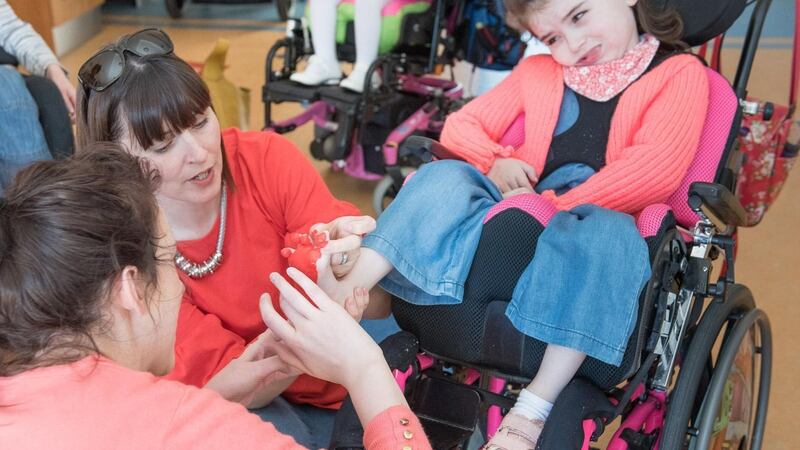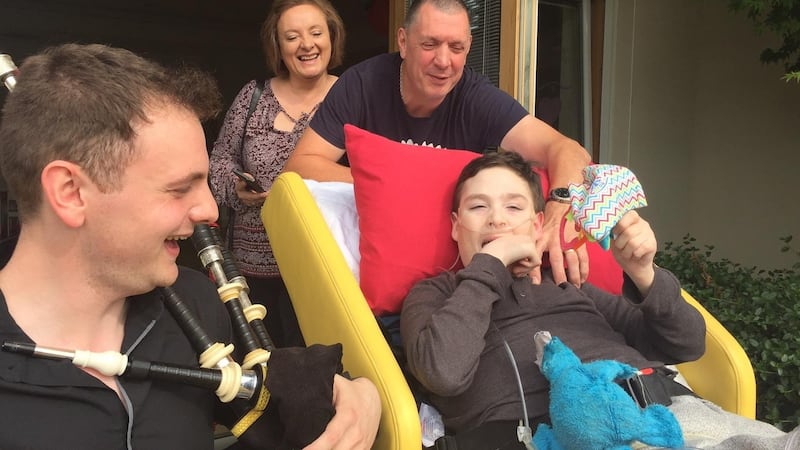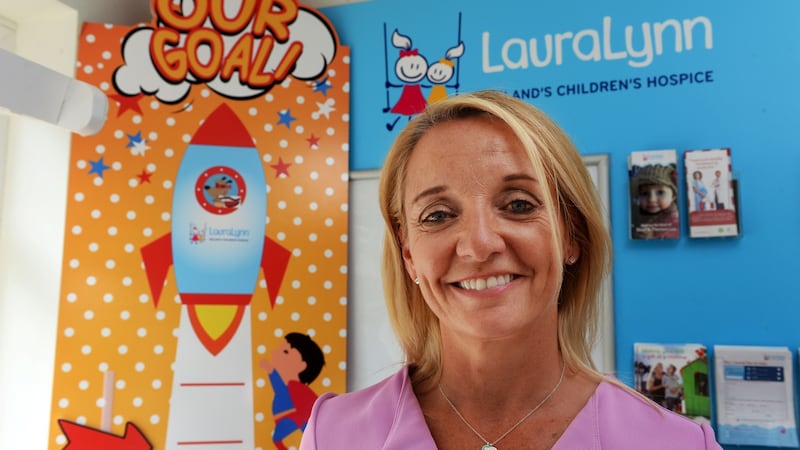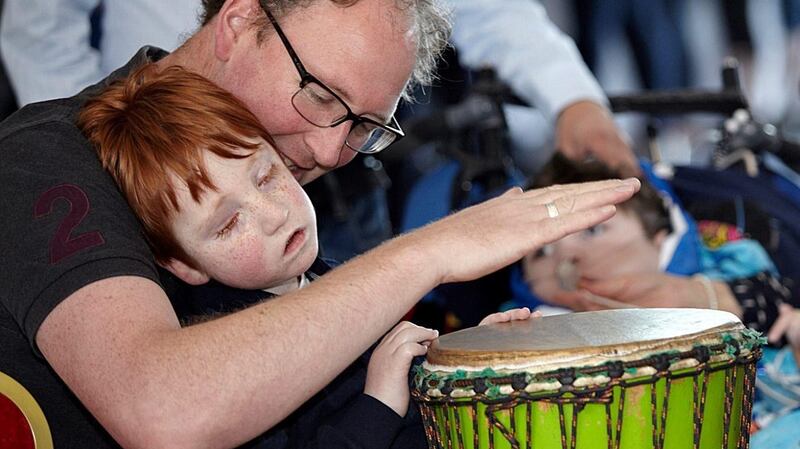Children die with no privacy in dingy rooms – that’s how a clinical nurse manager described the end-of-life scenario at Our Lady’s Hospital in Crumlin to an RTÉ documentary in 2003.
At the time, the idea of a dedicated children’s hospice in Ireland was still a very personal project being driven determinedly by Jane and Brendan McKenna who knew, from tragic first-hand experience, how badly it was needed. They had lost their two children – Laura at the age of four and Lynn at the age of 15 – within two years of each other.
Fifteen years on, not only is the LauraLynn Children's Hospice built and supporting families who are going through the worst possible time of their lives, but the whole children's palliative care system has improved enormously.
At least for some.
“Getting services funded equitably nationally is always the challenge,” says the new chief executive of LauraLynn, Orla O’Brien (50), who took up the job in May.
While in many people’s minds, “palliative care” is associated with imminent death, this is not the case – particularly with children.

“Children are so different from adults in that regard,” O’Brien explains, sitting in the modest Rowan House boardroom in an administrative building beside the hospice in Leopardstown, south Dublin. “A lot of their conditions are rare and very specific to childhood. Palliative care can last much longer – it’s like a rollercoaster, with peaks and troughs and can be quite unpredictable.” End-of-life care is a distinct, final phase of the palliative cycle.
Hospice’s vision
Amid the colourful and playful surroundings of the LauraLynn House, built in the grounds of the Children’s Sunshine Home, there’s no doubt that staff are delivering on the mantra “making the most of short and precious lives”. However, the hospice’s stated vision of “all children who need us, can access us” would sadly seem to still be some way off when you consider the maths.
There are close to 4,000 children living with a life-limiting illness in Ireland
Last year, LauraLynn worked with 157 families, while the Irish Hospice Foundation (IHF) estimates that there are close to 4,000 children living with a life-limiting illness in Ireland, about half of whom need active palliative care. Of those, about 350 will die each year – more than half in the first year of their life.
For every one of those 4,000 children, there are parents, sisters and brothers living with all the complexities and uncertainties that their loved one’s life-limiting condition brings.
“This is a long, long road these families are on,” says O’Brien simply. The hospice’s holistic service “gives people a chance to decompress” – either at its Dublin centre or through “LauraLynn@Home”, which operates within a two-hour drive of there.
The families on their books come from 23 counties – the exceptions being Cavan, Sligo and Leitrim, for no particular reason – and each is entitled to 15 nights’ respite at LauraLynn a year. Some may choose to leave their sick child in the trusted care of staff and go elsewhere, while others will take advantage of the family accommodation provided in the centre, which has eight hospice beds.
It is frequently said that this wraparound care gives the young patients a chance to be children, and allows their parents to be simply Mum and Dad, rather than carers. It is not only a time for free bed and board, relaxation and pampering, but also an opportunity for the whole family to avail of services such as psychological support and memory making.
“I feel very sorry for parents who have to fight to get respite,” says O’Brien. It is a time that they are their most vulnerable, with a sick child and “trying to keep the show on the road and manage everything”.
“Wouldn’t it be wonderful,” she muses, “if we had a system that was fully integrated, so you transitioned from your hospital to whatever community supports you needed. That they were there when you need them in the manner that you need them and in the amount you need them.” That may sound utopian, she acknowledges, “but that is what you have to strive for”.

Background
O’Brien is passionate about paediatric healthcare and has seen it from several angles. A native of Mitchelstown, Co Cork, she and her identical twin, Dervila Keane, started nursing training at the age of 17 at Our Lady’s Children’s Hospital, Crumlin and St James’s Hospital. “I stayed in paediatrics. I started in cardiac intensive care, that was my specialisation as a newly qualified nurse and then moved into management at a relatively young age and very much liked the management side.”
She rose to be deputy director of nursing at the Crumlin hospital before doing a stint as project manager at the Department of Health from 2013-2014 during James Reilly's tenure. Then she worked for four years as chief operations officer with the Children's Hospital Group, as it devised the design of the new children's hospital being built on the St James's campus. "I can't wait to go in and see it – walk in the door and know I had a part to play in that," she says, describing it as the most challenging phase of her career to date.
“But there is something massively satisfying about doing something that is very, very difficult. If it was easy, it would have been done years ago. It was a magnificent experience and huge learning.
“I think everybody will be extraordinarily proud of that hospital; I will be anyway for sure,” says the energetic but calm O’Brien, who has three teenage daughters – Ellie (16) and 14-year-old twins Rachel and Keelin – with her husband, Conor O’Brien. Even at first glance, and before asking, you just know she’s a chief executive who is going to tick those “early morning riser” and “physical fitness devotee” boxes.
Physical exercise
Yep, she’s up at 5.45am to go to the gym at UCD most mornings. Although she sounds almost apologetic about confirming her alarm clock setting – “when you’re in health, you’re an early riser” – she is much more forthright about the mental benefits of physical exercise.

“There is nothing like going for a run, playing golf or going to the gym – I have yet to do any of those and not feel better at the end of it and that’s why I do it,” she explains. “I try to instil that in my kids as well. It is not about the competitive side, I am not competitive at all in that regard – well, maybe a little bit, I can’t help that, I’m a twin,” she laughs.
Her new job has given her a shorter and easier commute so she is very grateful to be able to get exercise done at the beginning of the day and return to her home in Booterstown before driving to Leopardstown. “It just means you have eyeballed everyone in the family.”
I had been very used in my past career in working to get children better and in getting them home. But I was very aware that when they get home, it doesn't stop
While a nurse by background – “and always will be at heart” – with many years of experience in the acute services, she is now learning what paediatric care is like when you don’t have the solid structures of a hospital and the HSE around you. “I had been very used in my past career in working to get children better and in getting them home. But I was very aware that when they get home, it doesn’t stop.”
She saw the LauraLynn chief executive job as an opportunity to make changes for the better once the care transfers out of the hospital into the community.
“There is a whole different set of challenges when children are at home that are simply not there when they are in hospital and everything is at your fingertips. In hospital you need to get a doctor quickly, you can get one, if you need an X-ray, you can get one; in the community it is a whole different story.”
Fundraising
For the charity she is now heading, there is also the mammoth task of fundraising its multi-million euro budget. While the HSE pays it to provide disability services (under The Children’s Sunshine Home) in one part of the Leopardstown complex, LauraLynn has to raise €4.2 million this year to run the palliative care side. And, come January 1st, the “clock has to be reset”, as O’Brien puts it, and they have to start generating funds all over again for another year.
Although she has been “bowled over by the generosity and affection people have for LauraLynn”, it’s a huge pressure. There are seven staff involved in fundraising, which is not just about shaking a bucket anymore, she points out. “It is hard to be innovative and come up with the one big thing,” says O’Brien, who would clearly like to achieve a funding agreement with the HSE to run the palliative as well as the disability services.
Celebrating its seventh birthday on September 27th, LauraLynn has expansion ambitions but the where, what and how are currently up for discussion among all interested parties, in an attempt to “find out what expansion looks like”, she says. “It has to be where that need is, and what the need is.”
Without wanting to pre-empt the feedback, logic would tell you that having hubs around the country “would be a reasonable thing to do”, she suggests – say in Cork and Galway initially – and each of those would reach out to families in the hinterland.
“It’s about being ambitious but sensible as well – this will take time.” And, of course, it all comes back to funding: “I would not have any wish to grow and then not be able to sustain it.”
Palliative care in Ireland
Medical advancements mean the need for children’s palliative care is growing – more babies with life-limiting conditions are surviving after birth and living longer into childhood.
In addition to LauraLynn, other high-profile charities such as the Jack and Jill Children's Foundation and the Irish Hospice Foundation (IHF) work to complement services provided by the HSE and to help parents navigate "the system", which has improved considerably since publication of the first national policy for children's palliative care in 2010.

While the chief executive of the Irish Hospice Foundation, Sharon Foley, says she has been hugely impressed by the energy, consensus and collegiality around children's palliative care in recent years, it would be a mistake to think there isn't more to do. And she is "extremely frustrated" at the slowness of the HR process in the HSE around the appointment of a national programme manager to co-ordinate children's palliative care services.
“What we don’t want to happen is that attention moves from children’s palliative care,” she says. “It is probably the most traumatic incident that would happen in anybody’s life.” And the impact of every child’s death resonates in parents and siblings for the rest of their lives, she points out.
Respite for families
Foley is a member of a group of people working in this area who produced a pre-Budget submission on priorities for children’s palliative care 2019-2021. More respite for parents and increased bereavement support for families is among the immediate recommendations.
Parents have to have faith in those providing respite, that if anything goes wrong, they will be able to deal with it
Parents caring for a child with a life-limiting condition are there for the long haul and they become exhausted, Foley says, so much more needs to be done on respite – both in and outside the home. “The one thing that runs through all respite is that the parents have to have faith in those providing respite, that if anything goes wrong, they will be able to deal with it.
“If parents don’t get a break, these children will end up in acute hospitals,” she warns, “and that’s not what the parents nor the system wants.”
Night care scheme
The IHF is celebrating 10 years of its Nurses for Night Care scheme, which it runs in partnership with the Irish Cancer Society. On foot of referrals from the palliative care team, it can provide night nursing services to families for 10-14 nights at the end of life. "Families need to be able to sleep and rest; it is very intense caring for a child who is dying in a home setting," she adds.
The Jack & Jill Children’s Foundation, which supports families of children with life-limiting neurological conditions up to the age of five, also provides end-of-life care in the home for similarly aged children with any condition.
"Palliative care has come a long way, but it still has a long way to go," says the interim chief executive of Jack & Jill, Carmel Doyle, who was also a signatory to the pre-Budget submission.
The majority of families of children living with a life-limiting condition want to care for their child at home, yet they can do that only if they get the supports they need to do that, she stresses. “But it is in everybody’s interests because it is much more expensive to have a child in a hospital bed.”
Jack & Jill, which has to fundraise 80 per cent of its €3.5 million budget, is currently working with 355 families (Jack & Jill Week, on October 7th-13th, will raise awareness and funds). It has a core team of 13 nurses who act as case managers for families, assessing their needs, helping them access services and funding parents to pay for extra hours of nursing beyond what they receive from the HSE. A big flaw in the palliative care system at community level is that, unlike Jack & Jill, a lot of services switch off at weekends, says Doyle. “We are 365 days a year.”
The challenge for palliative care is to develop a more seamless system, she adds. “I think too many people working in this system are territorial about the service. Whereas we can’t go wrong if everything is child and family centred and the money follows the child, whether that child has to be in hospital, hospice or home.”
Palliative care in Ireland in numbers
- 4,000 children with life-limiting conditions
- 1,960 require active palliative care
- 350 of these children die each year
- 157 families supported by LauraLynn Children's Hospice
- 33 of the LauraLynn children died last year, with 13 of those receiving their end-of-life care at home
- 355 families of children aged 0-5 with neurological conditions are supported by Jack & Jill Children's Foundation
Sources: Irish Hospice Foundation, LauraLynn and Jack & Jill












